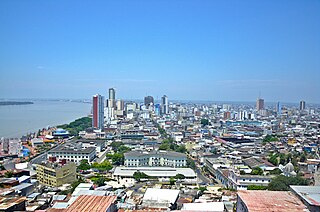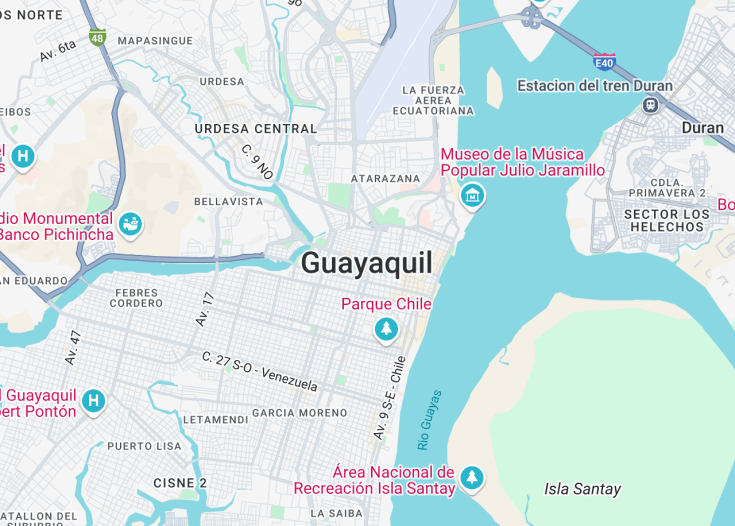Guayaquil, Ecuador’s bustling port city, holds a charismatic allure, blending vibrant urban life with rich historical heritage. As the gateway to the Galapagos Islands, it serves as a pivotal embarkation point, yet its own attractions are compelling. The cityscape is dotted with an array of cultural landmarks—from the vibrant Malecón 2000, a revitalized riverfront promenade, to the historic neighborhood of Las Peñas, showcasing brightly colored houses and artistic flair. Guayaquil’s tropical climate and welcoming locals add to its charm, making it an enticing destination for travelers seeking a mixture of modernity and tradition.
For an unforgettable experience, visit the Iguana Park, officially known as Parque Seminario. Here, amidst downtown Guayaquil, you can mingle with friendly iguanas that roam freely in this unique urban oasis.
Consider exploring the city on foot or by taking a guided tour to fully appreciate Guayaquil’s rich history and vibrant contemporary culture, ensuring a deeper understanding and connection with the city.
Top things to do & see in Guayaquil
Select the following sights and activities to discover best tickets and tours available in Guayaquil.
Guayaquil: The Pearl of the Pacific
| Country | Ecuador |
| Time in Guayaquil | GMT-5 |
| Language spoken | Spanish |
| Population | 2,700,000 (World Population Review, 2023) |
| Currency | United States Dollar (USD $) |
| Airports |
|
Guayaquil, Ecuador’s largest city, pulsates with vibrant cultural diversity and expansive urban life. Nestled along the western bank of the Guayas River that leads to the Pacific Coast, Guayaquil is not only the commercial heart of Ecuador but also a hub of artistic expression and architectural prowess. The city’s history stretches back to its founding in the early 16th century, evolving from a small indigenous village into a key player in the global trade network.
Guayaquil’s charm lies in its mixture of old and new, from the colonial splendor seen in neighborhoods like Las Peñas to the modern Malecón 2000, a boardwalk overlooking the river with galleries, museums, gardens, and landmark buildings. The city also serves as a gateway to the Pacific, with its port being one of the busiest in South America.
The warmth of its people, coupled with festive traditions and delicious gastronomy, invites both locals and tourists to enjoy its lively streets. The annual celebration of Guayaquil’s independence on July 24th showcases the city’s rich culture with parades, fireworks, and live performances, making it a vibrant place to experience the Ecuadorian lifestyle.
Where is Guayaquil?
Guayaquil is located in the coastal region of Ecuador, by the Guayas River. The city is a pivotal maritime port on the western coast of South America.
Distances:
| Route | Distance by car | Time by car |
|---|---|---|
| Quito to Guayaquil | 288 miles | Approx. 6 hours |
| Cuenca to Guayaquil | 125 miles | Approx. 3 hours 30 minutes |
What is Guayaquil famous for?
Guayaquil is renowned for its historical significance in Ecuador’s independence, its vibrant port activities, and as a cultural hub with attractions like the revitalized Malecón 2000, the historic neighborhood Las Peñas, and its diverse culinary offerings.
History
Pre-Colonial Era (Before 1538)
The origins of Guayaquil trace back to the Huancavilca tribe, an early indigenous group that occupied the region long before the arrival of the Spanish. Known for their skilled craftsmanship and trade, the Huancavilcas established a thriving settlement because of the strategic position along the coast which facilitated a robust trading network with other cultures along what is now the Ecuadorian coast.
Spanish Colonization (1538 – 1820)
Guayaquil was officially founded in 1538 by Spanish conquistador Francisco de Orellana. The city quickly became a significant port town, pivotal for the Spanish colonial empire in terms of trade and military logistics. Like many parts of Latin America during this period, Guayaquil experienced frequent pirate attacks which shaped much of the city’s early defensive strategies and fortifications.
Struggle for Independence (1820 – Early 19th Century)
Guayaquil played a heroic role in Ecuador’s struggle for independence from Spain. The city declared itself a free territory in 1820, which was a pivotal event leading to Ecuador’s eventual independence. It was in Guayaquil where notable meetings between South American liberators Simón Bolívar and José de San Martín took place, discussions that would shape the continent’s post-colonial configuration.
Modern Era (20th Century to Present)
The 20th century marked a period of significant growth and transformation for Guayaquil. The port city expanded beyond its historical boundaries, evolving into a major industrial and economic hub in Ecuador. Today, Guayaquil is recognized as the nation’s main port, supporting the majority of economic activities, including exports and imports essential to Ecuador and the broader South American economy.
Visit Guayaquil
What to see and do in Guayaquil
The bustling city of Guayaquil offers a blend of historical charm and modern attractions that make it a unique destination to explore. Visitors can start by touring the picturesque Las Peñas neighborhood, where colorful houses and artistic murals line the narrow streets, leading to a hilltop lighthouse that offers panoramic views of the city. Nature enthusiasts can stroll through the historical park of Guayaquil, which doubles as a zoo and cultural museum, providing insights into the country’s wildlife and heritage. The Malecón 2000 is a rejuvenated riverfront promenade filled with monuments, gardens, shopping centers, and eateries, ideal for a leisurely walk or enjoying the local cuisine. For a deeper dive into Ecuador’s artistic traditions, the Anthropological and Contemporary Art Museum houses an impressive collection worth visiting.
Festivals and Events in Guayaquil
Guayaquil is vibrant with cultural festivities throughout the year. Key events include the Guayaquil Independence Festival in July, which commemorates the city’s liberation with parades, live music, and fireworks. The city also hosts the International Film Festival in September, attracting film enthusiasts and international directors. Another significant celebration is the Semana Santa (Holy Week), where various religious and cultural activities paint the city, reflecting the deep-rooted traditions of its people.
Best time to visit Guayaquil
The best time to visit Guayaquil is between June and December when the weather is cooler and dry, providing comfortable conditions for exploring the city and engaging in outdoor activities. This period avoids the heavier rains of the earlier months, making it ideal for tourists looking to experience the city’s numerous attractions.
Is Guayaquil worth visiting?
Guayaquil indeed holds a special offer for every visitor, from its historical significance and cultural wealth to its vibrant modern life and natural beauty. The city serves as a gateway to the Galapagos Islands and a hub of Ecuadorian commerce and culture, making it a rewarding exploration spot for travelers intrigued by history, nature, or urban life. Between its interactive museums, dynamic festivals, and the warmth of its people, Guayaquil presents a compelling case for a must-visit destination on your travel list.










